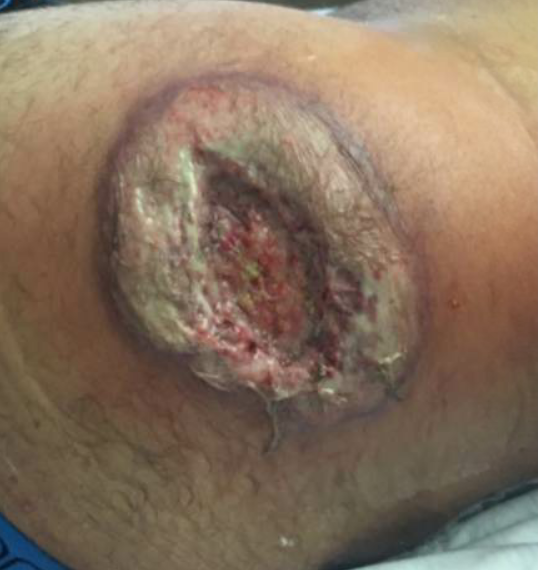Case Presentation: A 39 year old man with history of inflammatory acne and ulcerative colitis on immunosuppressants vedolizumab and azathioprine presented to an outside hospital for evaluation of low back pain, bilateral axilla pain and development of painful pustular abscesses over 1 month. Lumbar CT showed possible subcutaneous abscess around L4-L5 region. Patient underwent incision and drainage of the axillary and para-spinal abscess twice. Pathology showed benign vascular soft tissue with acute and granulating abscess with negative fungal stain. Spine MRI showed osteomyelitis of the L2 vertebral body. Patient was transferred to our hospital after failure to improve with broad spectrum antibiotics. On presentation, patient had tunneling abscesses in bilateral axilla, right paraspinal lumbar region, and left buttock. He had high fevers with elevated inflammatory makers, ferritin, and exquisite pain at abscesses sites. He was seen by Dermatology, Infectious Disease, Rheumatology, and Plastic Surgery. Our differential diagnoses included fungal dermatosis, drug fevers, and SAPHO syndrome (synovitis, acne, pustulosis, hyperostosis and osteitis). Due to initial negative pathology, there was a delay in a repeat biopsy. Patient’s symptoms were progressive despite supportive care and antibiotics, and a repeat skin biopsy showed neutrophilic infiltrate consistent with PG. The patient was begun on high dose corticosteroids which resulted in fever cessation, pain improvement, and wound healing. He was discharged on a steroid taper and plan to start Infliximab as an outpatient.
Discussion: Pyoderma gangrenosum (PG) is an ulcerative neutrophilic dermatosis seen in only 1-5% of inflammatory bowel disease (IBD) patients (1). However, it has a significant morbidity and mortality due to delay in diagnosis and treatment. Diagnosis of PG is difficult as PG must be diagnosed clinically by exclusion of infection, neoplasia, and other inflammatory conditions (3). In addition, PG can also present as part of autoinflammatory syndromes. Pathophysiology of PG is multifactorial and includes neutrophilic dysfunction, inflammatory mediators, and specific genetic mutations predisposing patients to this complex disease process (2). With regards to treatment, anti‐TNFα therapy (such as infliximab) appears to be the most effective (92% response rate) especially as compared with steroids monotherapy (8%). Between 23-50% of patients required only induction doses of infliximab for complete healing of PG (1).
Conclusions: Pyoderma gangrenosum (PG) is a rare dermatologic manifestation of Inflammatory Bowel Disease, and its diagnosis is one of exclusion. Misdiagnosis of PG can lead to treatment delay, unnecessary interventions, prolonged hospitalization and increased morbidity due to delay. The diagnosis of PG requires a high index of suspicion and early treatment could significantly reduce morbidity and hospitalization.

